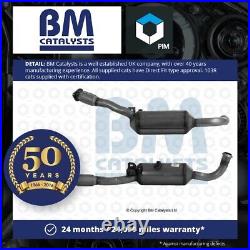Diesel Particulate Filter DPF + Fitting Kit fits OPEL VIVARO A 2.0D 06 to 10 BM




Please use the make model tool above to check the part fits your vehicle. Diesel Particulate Filter DPF + Fitting Kit fits OPEL VIVARO A 2.0D 06 to 10 BM. To be used with part number(s). Soot/Particulate Filter, exhaust system. Diesel Particulate Filters (DPF). Diesel vehicles have become increasingly popular across the world as diesel engine technology continues to advance due to their superior fuel economy over petrol vehicles. The drawback with diesel vehicles however, is that they have high NOx and particulate emissions compared to their petrol counterparts. In response to this, existing Euro Emissions Standards were tightened and greater environmentally friendly initiatives were developed, such as the implementation of “Stop/Start” technology in many modern vehicles. One of the most prominent developments however was the introduction of Diesel Particulate Filters (DPFs). What are they and how do they work? The Diesel Particulate Filter is part of the exhaust system which functions to remove particulate matter (soot) from the exhaust gasses. It does this by capturing, containing and converting these soot particulates into Carbon Dioxide via a process of Regeneration. Exhaust gasses containing soot enter the DPF channels which are closed off at alternating ends. The channel walls are porous, allowing exhaust gasses to pass through whilst retaining and trapping the soot particles in the DPF as the gasses are forced through. Clean exhaust gasses then exit the DPF and trapped soot particles are eliminated during the Regeneration cycles to prevent blockages and therefore, prevent the DPF’s function from being affected. The Engine Management System (ECU) constantly monitors the filter’s performance and will carry out this Regeneration as necessary. What are they made from? Cordierite DPFs look very similar to Catalytic Converters and are mostly used in additive systems in conjunction with Diesel Oxidisation Catalysts. They are often used in aftermarket products and can be found in our standard DPF range. Silicon Carbide (Sic) DPFs are constructed from small sections cemented together. They are more commonly used in O. E and Catalysing DPFs and are classed as a BM Premium product due to their high thermal and strength endurance. As the DPF acts as a “soot trap”, it has to be able to clean itself to prevent it becoming blocked and affecting the running of the vehicle. This is the process of Regeneration. There are 3 different types of Regeneration – Passive, Active and Forced. Regeneration “burns off” (oxidises) the particulates that have accumulated in the DPF. Passive Regeneration is a process of soot reduction via natural conversion. It occurs when ideal driving conditions apply 60mph for 15 minutes – e. The DPF becomes hot enough to burn off some of the trapped particulates naturally between 350-500°C – organic conversion. The carbon soot particles are converted into carbon dioxide by a reaction with nitrogen oxide using the platinum coating which works as a catalyst. Active Regeneration occurs when the optimum exhaust gas temperatures can no longer be maintained, meaning Passive Regeneration can no longer take place. Therefore, Active Regeneration is an ECU led process that increases the EGT (exhaust gas temperature) to 500-800°C. When the carbon soot deposits in the filter reach a certain level, the engine management system initiates the Regeneration process which lasts around 10 minutes. Forced Regeneration involves very high temperatures and is carried out by garages with diagnostics equipment. The very high temperatures applied during Active and Forced Regeneration can lead to an accumulation of ash and aging. The build-up of ash is treated by physical intervention such as chemical cleaning, ultrasonic cleaning or replacement of the DPF. Compatible with the following OEM references. NISSAN PRIMASTAR Van (X83) 2.0 dCi 115. Construction Year to: 09/2013; Emission Standard: Up to Euro 4; Vehicle Equipment: for vehicles with diesel soot filter. NISSAN PRIMASTAR Van (X83) 2.0 dCi 90. NISSAN PRIMASTAR Van (X83) dCi 120. NISSAN PRIMASTAR Van (X83) dCi 90. OPEL VIVARO A Bus (X83) 2.0 CDTI (F7, J7, A07). Construction Year to: 11/2010; Emission Standard: Up to Euro 4; Vehicle Equipment: for vehicles with diesel soot filter. OPEL VIVARO A Platform/Chassis (X83) 2.0 CDTI. Construction Year from: 08/2006; Construction Year to: 11/2010; Emission Standard: Up to Euro 4; Vehicle Equipment: for vehicles with diesel soot filter. OPEL VIVARO A Van (X83) 2.0 CDTI (F7). RENAULT TRAFIC II Bus (JL) 2.0 dCi 115. RENAULT TRAFIC II Bus (JL) 2.0 dCi 90. RENAULT TRAFIC II Platform/Chassis (EL) 2.0 dCi 115 (EL0H). RENAULT TRAFIC II Platform/Chassis (EL) 2.0 dCi 90 (EL0H). RENAULT TRAFIC II Van (FL) 2.0 dCi 115 (FL01, FL0U). RENAULT TRAFIC II Van (FL) 2.0 dCi 90 (FL0H). VAUXHALL VIVARO A Bus (X83) 2.0 CDTI. VAUXHALL VIVARO A Platform/Chassis (X83) 2.0 CDTI. VAUXHALL VIVARO A Van (X83) 2.0 CDTI. This can include addresses in Scotland, Northern Ireland, Isle of Man, Shetland Islands and Channel Islands.

